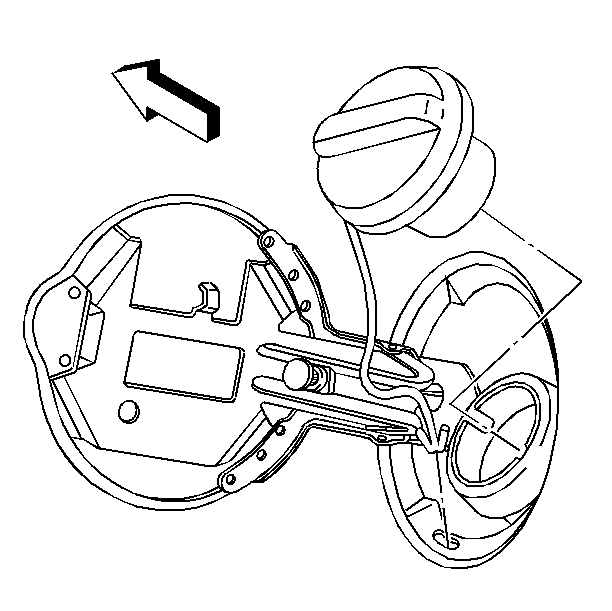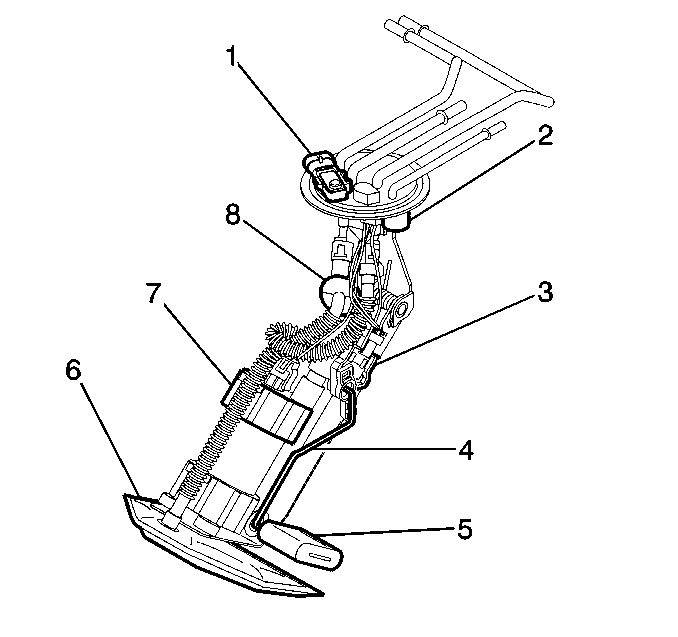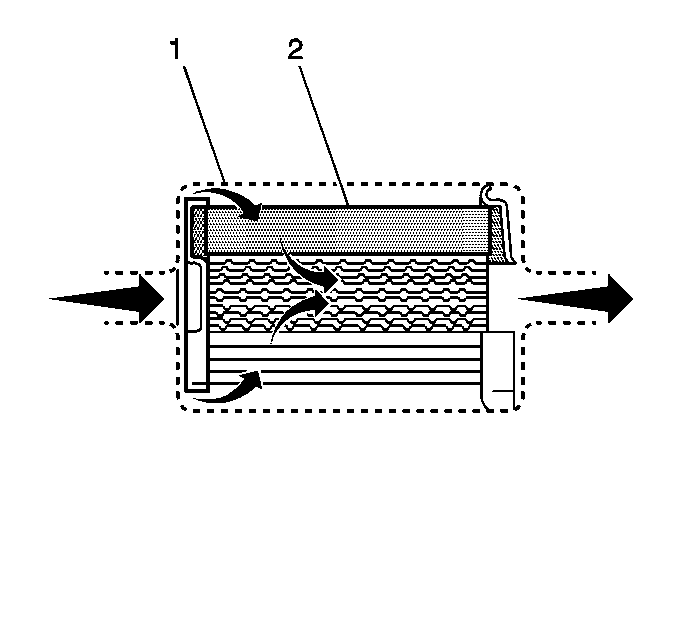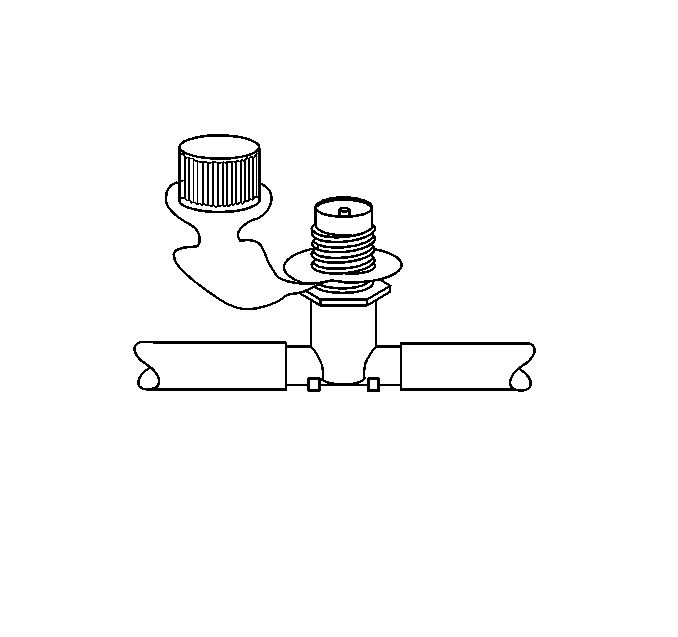System Overview
The fuel tank stores the fuel supply. An electric fuel pump, located in the fuel tank with the fuel sender assembly, pumps fuel through an in-line fuel filter to the fuel rail assembly. The pump provides fuel at a pressure greater than is needed by the injectors. The fuel pressure regulator, part of the fuel sender assembly, keeps fuel available to the injectors at a regulated pressure. A separate pipe returns unused fuel to the fuel tank.
Fuel Tank Vent Valve
The fuel tank vent valve is located in the rear of the vehicle near the fuel tank. The fuel tank vent valve is a pressure/vacuum relief valve. When the fuel tank pressure exceeds a specified pressure, the valve opens allowing the tank pressure to bleed off. When the fuel tank is in a vacuum condition, the vent valve opens when the vacuum is within a specified range allowing fresh air to be pulled in.
Fuel Tank
The fuel tank stores the fuel supply. The fuel tank is located in the rear of the vehicle. The fuel tank is held in place by two metal straps that attach to the frame. The fuel tank is made of steel and is coated internally with a special corrosion inhibitor.
Fuel Tank Filler Pipe
The fuel tank filler pipe has a built-in restrictor and deflector in order to prevent refueling with leaded fuel.
Fuel Filler Cap

Notice: If a fuel tank filler cap requires replacement, use only a fuel tank filler cap with the same features. Failure to use the correct fuel tank filler cap can result in a serious malfunction of the fuel and EVAP system.
The fuel tank filler pipe has a tethered fuel filler cap. The cap requires a quarter of a turn to remove it. A torque-limiting device prevents the cap from being over tightened. To install the cap, turn the cap clockwise until you hear three audible clicks. This indicates that the cap is correctly torqued and fully seated.
Fuel Sender Assembly

The fuel sender assembly is inside the fuel tank attached to the top of the fuel tank. The fuel sender assembly consists of the following major components:
| • | The fuel level sensor (3). |
| • | The fuel tank pressure sensor (1). |
| • | The fuel pump (7). |
| • | The fuel pressure regulator (8). |
| • | The fuel pump strainer (6). |
Fuel Pump

The fuel pump (7) attaches to the fuel sender assembly inside the fuel tank. The fuel pump is an electric high pressure gear rotor pump. The fuel pump pumps fuel to the fuel rail assembly at a specified flow and pressure. Excess fuel returns to the fuel tank by the return pipe. The fuel pump delivers a constant flow of fuel to the engine even during low fuel conditions and aggressive vehicle maneuvers. The PCM controls the electric fuel pump operation through a fuel pump relay. The fuel pump flex pipe has a quick-connect fitting. The fuel return hose attaches to the fuel pressure regulator (8). The fuel pump flex pipe acts to dampen the fuel pulses and noise generated by the fuel pump.
Fuel Pressure Regulator Assembly
The fuel pressure regulator is a part of the fuel sender assembly fuel return pipe. The fuel pressure regulator is a diaphragm operated relief valve. A software bias compensates the injector on-time because the fuel pressure regulator is not referenced to manifold vacuum. The fuel injector pulse width varies with the signal from the MAP sensor. With the ignition ON and the engine OFF, system fuel pressure at the pressure test connection should be 380-410 kPa (55-60 psi). If the pressure is too low, poor performance could result. If the pressure is too high, excessive odor and a Diagnostic Trouble Code (DTC) P0132, P0152, P0172 or P0175 may result. Refer to Fuel System Diagnosis for information on diagnosing fuel pressure conditions.
Fuel Pump Strainer
The fuel pump strainer attaches to the lower end of the fuel pump and the lower end of the fuel return pipe. The fuel pump strainer is made of woven plastic. The functions of the fuel pump strainer are to filter contaminants and to wick fuel. The fuel pump strainer is self-cleaning and normally requires no maintenance. Fuel stoppage at this point indicates that the fuel tank contains an abnormal amount of sediment or water. Clean the fuel tank and replace a plugged fuel pump strainer with a new one.
In-Line Fuel Filter

The fuel feed pipe has a steel fuel filter installed ahead of the fuel injection system. The paper filter element (2) traps particles in the fuel that may damage the injection system. The filter housing (1) is made to withstand maximum fuel system pressure, exposure to fuel additives, and changes in temperature. The fuel filter has a quick-connect inlet fitting and a threaded outlet fitting. The threaded fitting is sealed with an O-ring. There is no service interval for fuel filter replacement. Replace a restricted fuel filter.
Fuel Feed and Return Pipes
The fuel feed pipe carries fuel from the fuel tank to the fuel rail assembly. The fuel return pipe carries fuel from the T-connector located on the outlet side of the fuel filter back to the fuel tank. The fuel pipes consist of three sections:
| • | The rear fuel pipe assemblies are located from the top of the fuel tank to the chassis fuel pipes. The rear fuel pipes are constructed of nylon. |
| • | The chassis fuel pipes are located under the vehicle and connect the rear fuel pipes to the engine compartment connecting fuel pipe. These pipes are constructed of steel. |
| • | The engine compartment connecting fuel pipe connects the chassis fuel pipe to the engine fuel rail. This fuel pipe is constructed of nylon. |
Nylon Fuel Pipes
Caution: In order to Reduce the Risk of Fire and Personal Injury:
• If nylon fuel pipes are nicked, scratched or damaged during installation,
Do Not attempt to repair the sections of the nylon fuel pipes. Replace them. • When installing new fuel pipes, Do Not hammer directly on the
fuel harness body clips as it may damage the nylon pipes resulting in a possible
fuel leak. • Always cover nylon vapor pipes with a wet towel before using a
torch near them. Also, never expose the vehicle to temperatures higher than
115°C (239°F) for more than one hour, or more than 90°C (194°F)
for any extended period. • Before connecting fuel pipe fittings, always apply a few drops
of clean engine oil to the male pipe ends. This will ensure proper reconnection
and prevent a possible fuel leak. (During normal operation, the O-rings located
in the female connector will swell and may prevent proper reconnection if
not lubricated.)
Nylon fuel pipes are designed to perform the same job as the steel or flexible fuel pipes or hoses that they replace. Nylon pipes are constructed to withstand maximum fuel system pressure, exposure to fuel additives, and changes in temperature. There are three sizes of nylon pipes used: 3/8 in ID for the fuel feed, 5/16 in ID for the fuel return, and 1/2 in ID for the vent. Heat resistant rubber hose and/or corrugated plastic conduit protect the sections of the pipes that are exposed to chafing, high temperature or vibration.
Nylon fuel pipes are somewhat flexible and can be formed around gradual turns under the vehicle. However, if nylon fuel pipes are forced into sharp bends, the pipes will kink and restrict the fuel flow. Also, once exposed to fuel, nylon pipes may become stiffer and are more likely to kink if bent too far. Take special care when working on a vehicle with nylon fuel pipes.
Quick-Connect Fittings
Quick-connect fittings provide a simplified means of installing and connecting fuel system components. The fittings consist of a unique female connector and a compatible male pipe end. O-rings, located inside the female connector, provide the fuel seal. Integral locking tabs or fingers hold the fittings together.
Fuel Pipe O-Rings
O-rings seal the threaded connections in the fuel system. Fuel system O-ring seals are made of special material. Service the O-ring seals with the correct service part.
EVAP Pipes and Hoses
The EVAP pipes extend from the fuel sender assembly and the EVAP canister vent solenoid to the EVAP canister. The EVAP purge pipe extends from the EVAP canister to the EVAP purge valve in the engine compartment. The rear pipes and the engine compartment pipe are constructed of nylon. The chassis EVAP purge pipe is constructed of steel.
Enhanced Evaporative Emission (EVAP) Service Port

The enhanced EVAP service port is located in the EVAP pipe in the engine compartment near the purge solenoid. The service port is identified by a green colored cap. The port contains a schrader valve and a fitting to allow the connection of the J 41413 EVAP Pressure/Purge Diagnostic Station for diagnosis of the evaporative emission system.
